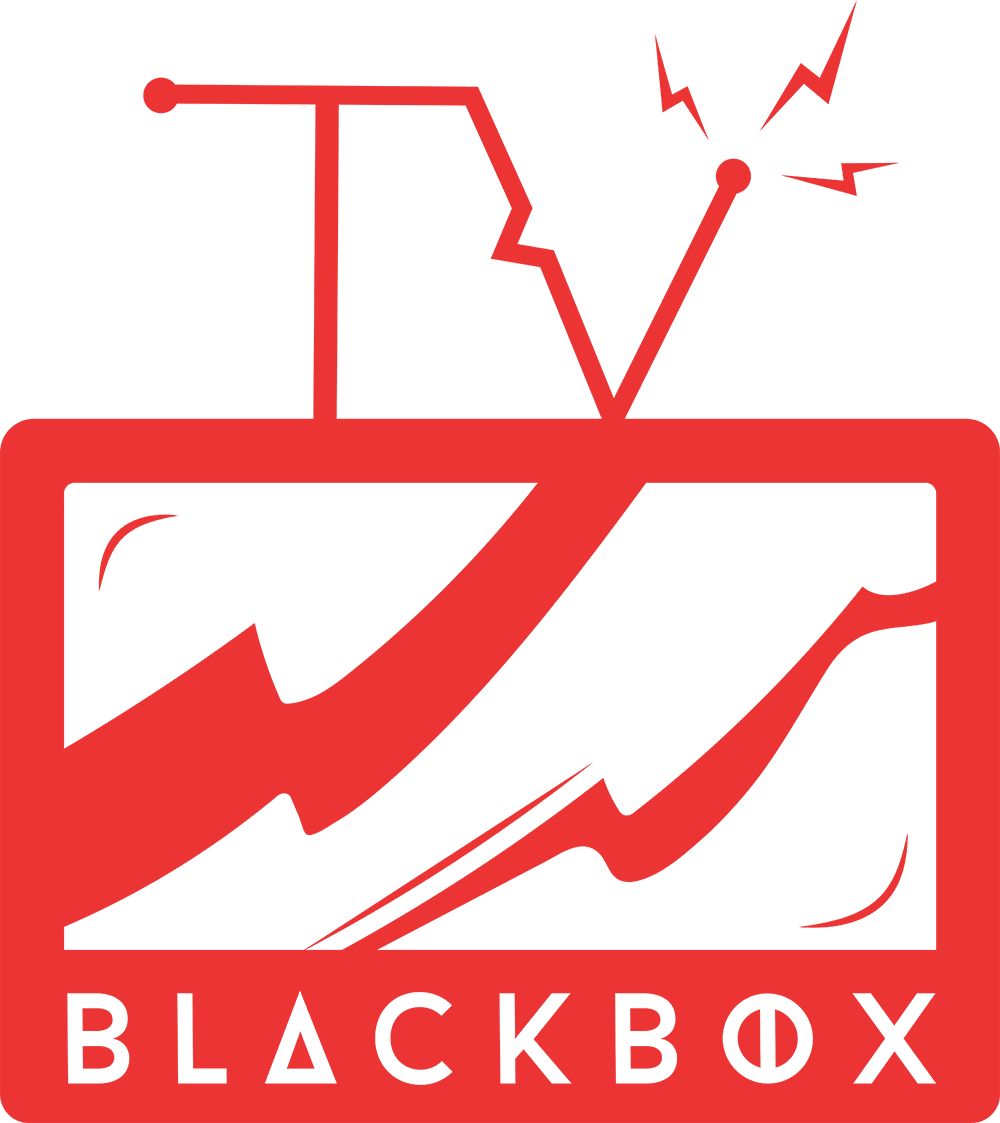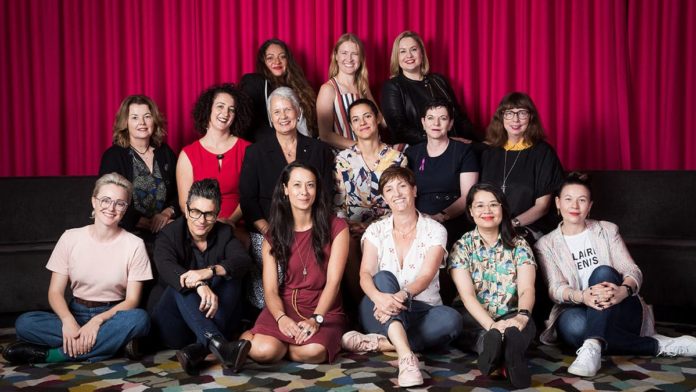Screen Australia today announced it is on track to meet its new Gender Matters KPI at the end of 2021/22, with 57% of key creative roles across approved development and production funding held by women and female-identifying people in 2019/20.
The KPI is to have at least 50% of the key creative roles across all formats (feature drama, television drama, online drama and documentary) that receive Screen Australia development and production funding to be held by women and female-identifying practitioners, across a three-year-average. This is the first year of the new KPI reporting and considers the key creative roles of producer, writer and director. The tracking period is 2019/20 to 2021/22.
“We want to see real and significant inclusion of women in screen projects and ensure our female and female-identifying practitioners are equally represented in our industry,” said Joanna Werner, Screen Australia Board Member, chair of the Gender Matters Taskforce and acclaimed producer.
“While we are encouraged by the result overall, the KPI has been lifted by high levels of participation by women in development applications, and these high levels are not yet carrying through to some areas of production.”
“We can also see in industry-wide data that tracks participation over an eight-year period that men continue to dominate all key creative roles in feature production, and writer and director roles in television drama, online drama and documentary.”
“Systemic change is not something that happens overnight and we recognise that there is still more progress to be made. We hope to gain valuable insights from this three-year KPI reporting period, as we continue to work towards achieving gender parity,” said Joanna Werner.
Screen Australia has also released data relating to protagonists of successful feature, online and television drama development and production applications in order to monitor female representation on screen, however this is not counted towards the overall KPI.
“Screen Australia puts consideration around what stories are being told and who is telling them at the centre of our decision making. The inclusion of development data in the Gender Matters KPI shows our commitment to ensuring women are not an afterthought or quota for inclusion that needs to be filled on projects when they reach production – they are present every step of the way,” said Nerida Moore, Screen Australia’s Head of Development.
“While the first year results for development are promising, the process of developing a project can take anywhere upwards of five years for a feature drama, and around two years for episodic content to move in to production. Many projects we see included in this year’s successful development applications won’t reach production by the end of this three year KPI reporting period. A number of factors influence conversion rates including marketplace, natural attrition and creative reasons. We want to continue to see strong results across every application area and hope this in time converts to more female-led projects being made,” said Nerida Moore.
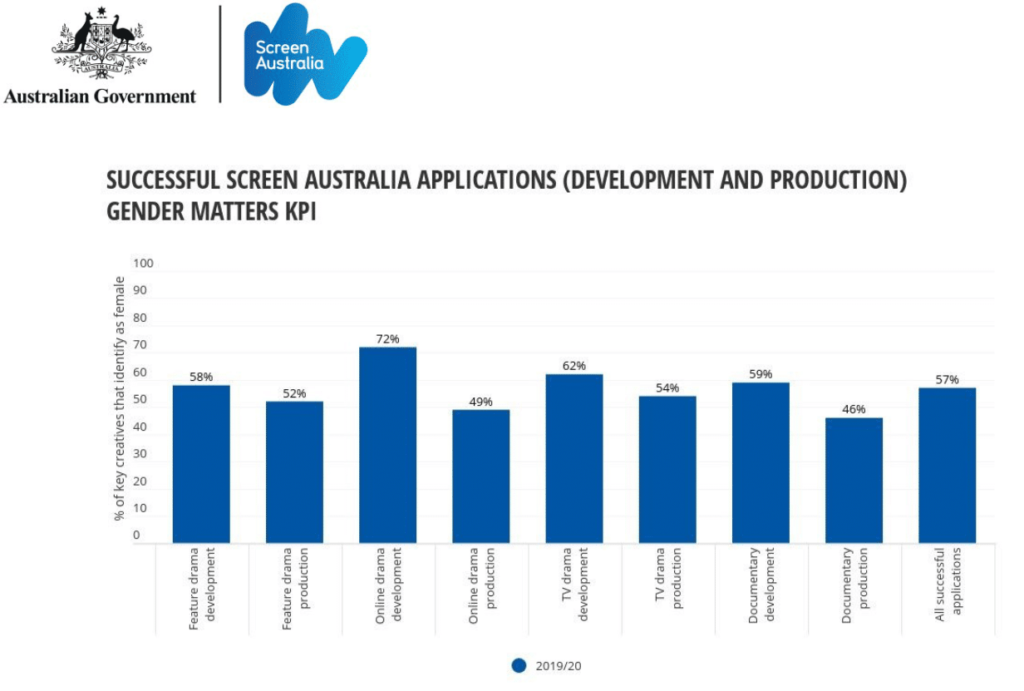
Women made up the majority of the key creative roles in successful applications in Screen Australia development programs for 2019/20, with particularly high participation in online drama development (72%) and television drama development (62%). Across production formats, successful applications in feature drama production and television drama production featured women in 52% and 54% respectively in all key creative roles. Online drama production is at 49%, with documentary production reporting also below parity at 46% across all key creative roles.
While only one year of data is available for development applications, these results indicate that several barriers to female participation occur when projects move through to production.

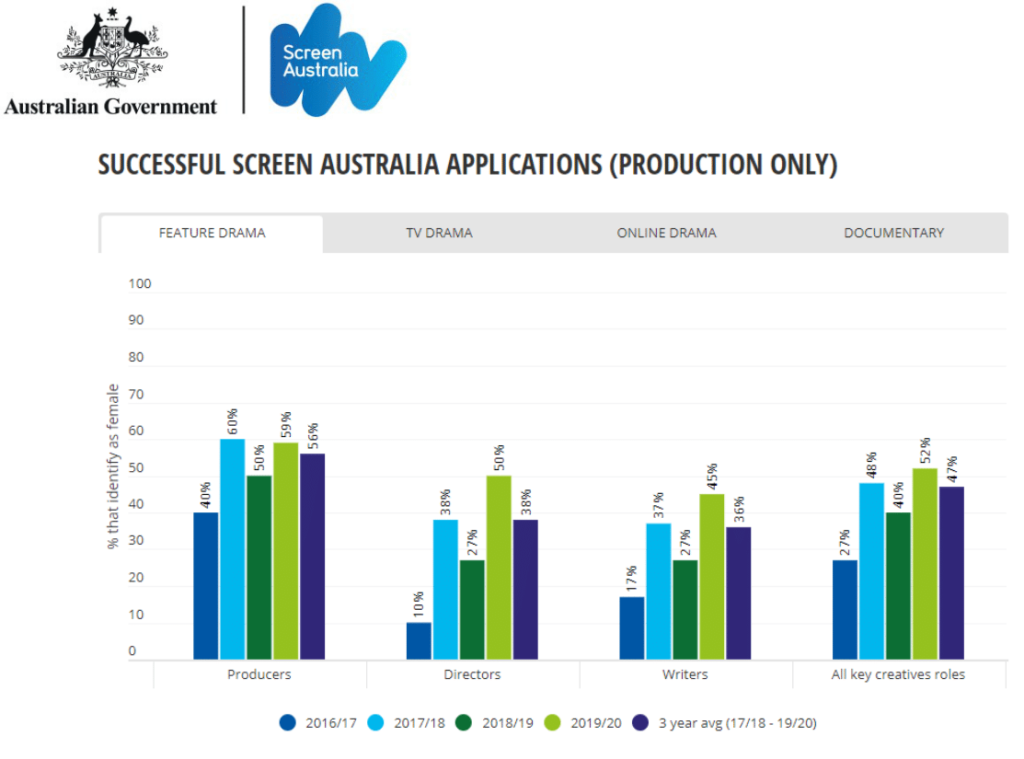
Screen Australia has released data for approved production applications over a four year period from 2016/17 to 2019/20. Yearly results can be influenced by a range of factors and the 2019/20 data considers writer, producer and director roles based on the most recent information processed in Screen Australia’s applications database (see Notes on method below). Despite improvement in several areas over the last four years, the 2019/20 data continues to display areas of disparity within production applications.
“What’s heartening to see is that over the last four years, the percentage of women in all key creative roles in feature drama production has increased from 27% to 52%,” said Joanna Werner.
Television drama production also saw an increase from 47% to 54% and online drama production from 44% to 49%. Across all key creative roles, documentary production saw a small increase from 51% in 2016/17 to 55% in 2017/18, and remained at this percentage in 2018/19. However, this has decreased to 46% in 2019/20.
Women were consistently well represented across every format in producer roles in approved Screen Australia production applications in the first year of data for this KPI reporting period. In 2019/20, women represented 59% of producers in feature drama, 61% in television drama, 51% in online drama and 55% in documentary.
For the first time in four years, women represented more than 50% of all key creative roles in successful feature drama production applications in 2019/20. Historically, women have been under-represented in feature drama. Feature drama writers increased from 17% in 2016/17 to 45% in 2019/20. Director roles have also increased to 50% in 2019/20 – this marked the highest result in the past four years, and a significant increase from just 10% in 2016/17. The increase for this year can be attributed in part to two anthology productions with multiple female creatives: Cook 2020: Our Right of Reply and Here Out West. There has also been significant progress made in the percentage of female producers in feature drama increasing from 40% in 2016/17 to 59% in 2019/20.
We continue to see strong results in television drama production across all key creative roles, with steady growth from 2016/17. In 2019/20 women represented 54% of all key creative roles across approved production applications, with writer roles at 53%, and a 9% increase in director roles to 51% on the previous year.
While all key creative roles in successful documentary and online drama production applications did not reach parity in 2019/20, more than 50% of producer roles were women in both formats, with 51% in online drama production and 55% in documentary production. For the first time in four years, writer roles for successful online drama productions reached parity with women representing 52% in 2019/20, an increase of 6% from 2018/19.
“Despite the decline in online drama and documentary production, we are buoyed by the strong female-led projects coming through in our applications. This includes the recent ABC iView comedy series Retrograde, inspired by and co-created in lockdown by Meg O’Connell and directed by Natalie Bailey, and SBS On Demand commissioned Tasmanian noir-mystery The Tailings, directed by emerging talent Stevie Cruz-Smith. There have also been some fantastic female-led documentaries created including Brazen Hussies, a documentary about the Australian women’s liberation movement which is due for release in cinemas later this year, and MuM – Misunderstandings of Miscarriage, written and directed by Tahyna MacManus, which recently premiered on Stan,” said Joanna Werner.
PROTAGONIST DATA
Screen Australia has released protagonist data for successful feature, television and online drama development and production applications in 2019/20. While protagonist data is not included in the KPI, female representation on screen is also an important element of female storytelling. Across all formats, 62% of the protagonists in successful applications were female.
A breakdown of the percentage of female protagonists per year from 2016/17 to 2019/20 for successful production applications across drama formats has also been released. Over this four year period there has been a steady increase in feature drama (from 27% to 56%) and television drama (from 43% to 62%).
“As Screen Australia addresses the issue of representation of women behind the camera and encourages parity in creative teams, we expect this to flow on to the stories that are being told on our screens. Audiences value authentic stories and this is evident in projects like AACTA Award-winning The Letdown and Australian box office success Ride Like A Girl. Not that women should be limited to telling stories about women. But it is worth celebrating that these were stories made about women, told by women that proved to be both culturally significant and commercially successful,” noted Nerida Moore.
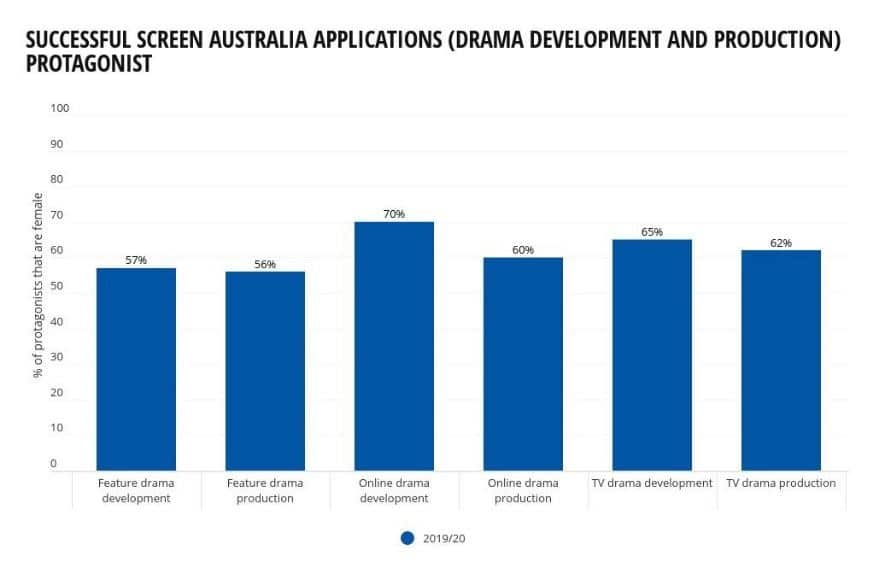
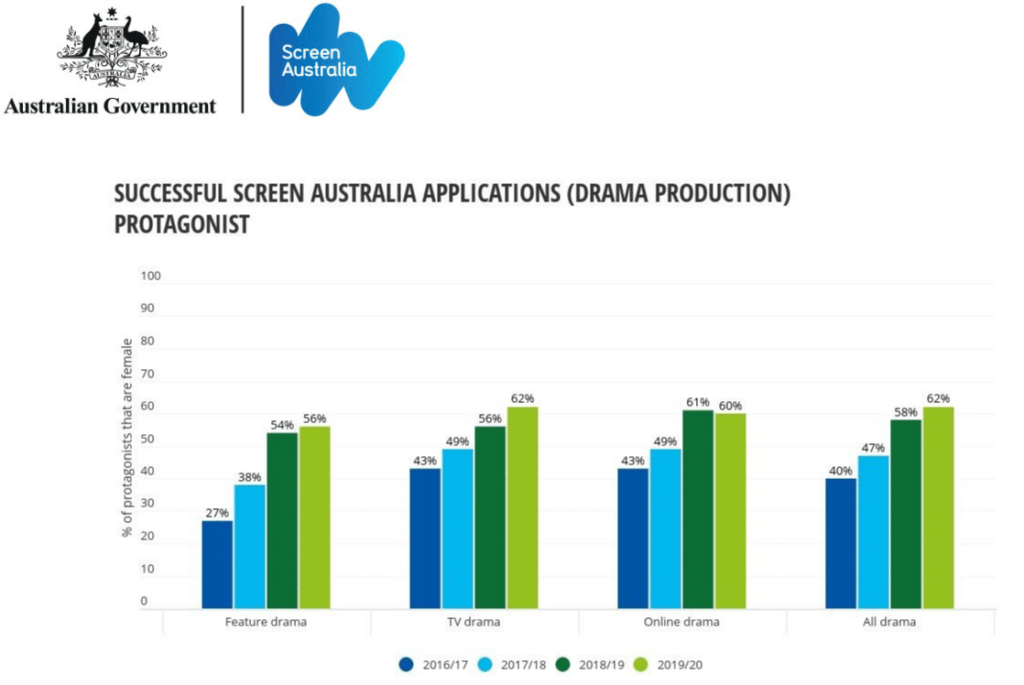
NEW INDUSTRY DATA
Screen Australia has also released updated industry-wide data charting female participation in Australian feature film, television drama, documentary, and, for the first time, online drama production. The data released is over two four-year reporting periods from 2011/12 to 2014/15 and 2015/16 to 2018/19, with data also provided across the entire eight-year period. The industry-wide data is a count of individuals working in the key creative roles of producer, writer and director. This is different from the Screen Australia applications which measures the gender of each role, regardless of who is in it. The data reveals that women still make up less than half of the writers and directors working on Australian productions.
There are significant signs of improvement in television drama with a 10% increase across producer, writer and director roles across the two four-year reporting periods. However, participation in writer and director roles is still well below parity.
Key creative roles in feature drama continue to show the highest levels of imbalance, with only 18% female directors in feature film from 2015/16 to 2018/19, and an average of 20% over the eight-year period. There was a small improvement in producer roles, with an increase from 35% in 2011/12 to 2014/15, to 38% for 2015/16 – 2018/19, and writer roles remained at 23% over both four-year periods.
Across the industry, women in documentary writer roles had a slight decrease from 43% in 2011/12 to 2014/15 to 41% in 2015/16 to 2018/19, and directors also dropped 1% to 37% during the same time period. Producers have remained at parity over the reporting periods.
Due to the emerging nature of online platforms over the last eight years, data has been published for the entire period from 2011/12 to 2018/19. This demonstrates women are underrepresented in the format across both writing roles (at 41%) and director roles (at 38%). However, this period showed strong results for women in producing roles, who accounted for 63%.
Screen Australia funding decisions in 2019/20 generally show higher participation than the broad industry trends.
“While we have seen improvements across television drama in the industry data, the underrepresentation of women across many key roles, particularly writer and director roles, means we aren’t seeing enough meaningful change in the sector. Women are still being underutilised in key creative roles. This is not something one agency and one Taskforce can solve. It’s a cultural change the entire industry needs to embrace and act upon,” said Joanna Werner.
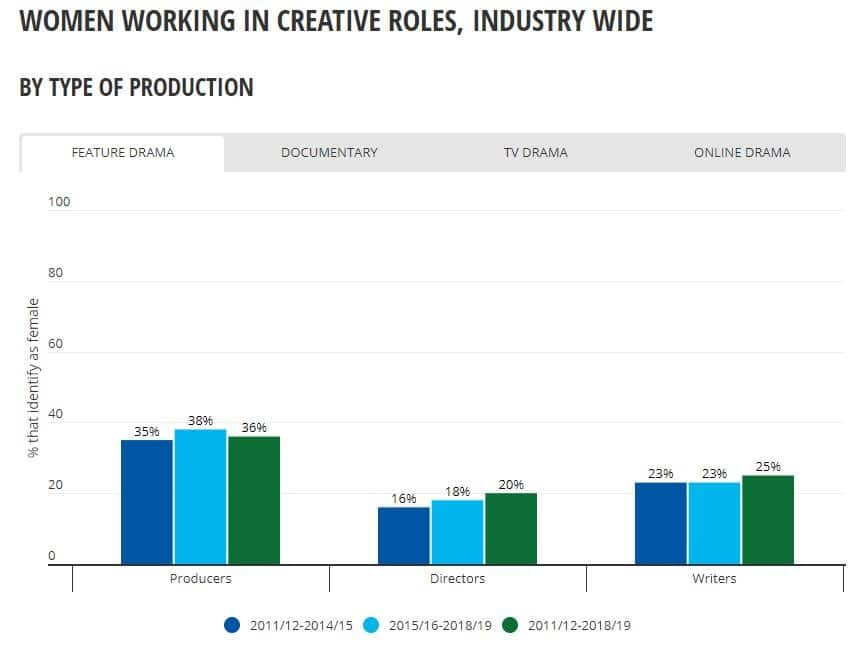
LOOKING AHEAD
The far-reaching disruption of the sector from March 2020 as a result of the COVID-19 pandemic has had a profound impact on screen practitioners. However, during this time Screen Australia has continued to fund projects in development and production, as well as announcing the Temporary Interruption Fund and the COVID-19 Budget Support Fund to get productions back up and running.
“The effects the COVID-19 pandemic has had, and continues to have, on the screen sector are vast. The entire industry, like many around the world, is navigating this difficult time together and working towards getting practitioners back to work and ensuring productions can begin again as safely as possible. It’s important we break down any further barriers to female participation that these challenges may create,” said Joanna Werner.
The Gender Matters Taskforce, which provides independent advice to the agency and works beyond Screen Australia’s direct sphere of influence to deliver outcomes for female creatives and assist in the broader industry efforts to achieve gender parity, has this year identified three focus areas to better achieve gender parity in the industry. These focus areas are Outreach and Career Progression, Markets and Audiences, and Key Roles and Heads of Department. Initiatives as part of these focus areas will be announced over the coming months.
As cinemas open up around the country, it is hoped Australian audiences will embrace the strong slate of upcoming female-led projects including The Drover’s Wife: The Legend of Molly Johnson, written and directed by Leah Purcell; Blaze, the debut feature from award-winning fine artist Del Kathryn Barton; and Indigenous coming of age drama Sweet As, from Jub Clerc, which will head into production in the Pilbara region soon.
“Australian audiences can not only support female-led stories at the cinema, but with their remote controls and by watching online. We have many exciting projects in the pipeline including drama series Eden from Every Cloud Productions’ Fiona Eagger and Deb Cox with episodes to be directed by Mirrah Foulkes; ABC comedy series Entitled (co-created, co-written, directed by and starring Kitty Flanagan) and Love Bug, an IGTV series filmed in self-isolation from writer/director Imogen McCluskey,” said Joanna Werner.
“At Screen Australia, gender equity, inclusion and diversity are at the heart of all the agency’s funding decisions. We want to ensure the momentum this initiative has worked to build continues. We have seen, particularly over the last few years, audiences embrace authentically told stories and we look forward to continuing to champion excellence and equality,” said Nerida Moore.
NOTES ON METHOD
Data related to Screen Australia funding applications (including the Screen Australia KPI)
Data is based on applications: applicants nominate the gender of writer, producer, director and other roles, selecting either male, female, X (Indeterminate/Intersex/Unspecified) or prefer not to disclose.
All documentary titles, including titles funded by the Online and Indigenous departments, are categorised as Documentary. Producer Equity Program (PEP) documentary projects are excluded as they do not undergo creative assessment.
Drama applications are generally sorted by funding program. 19/20 title With or Without You was funded via Feature Production, but is categorised here as Feature Development, as the funding went to Development-like activities.
Story Development titles are categorised by their first release platform.
Decisions to approve or decline funding are counted. Note some titles receive multiple approvals in the same year. Variations to funding for the same activity, such as production funding variations, are not counted.
Some applications, including Drama Story Development, may be assessed at multiple stages – decisions to approve or decline funding are counted. LOI approvals are only counted if a funding decision is not made in the same financial year.
Revocations of funding will be updated retrospectively for the current KPI period 19/20 – 21/22.
Includes Screen Australia initiatives administered by third parties where data is available. Data was not available for unsuccessful applications for one initiative.
Some titles, such as anthologies, involve larger numbers of creative roles. The 19/20 dataset involves two anthologies approved for feature production funding: Cook 2020: Our Right of Reply/ Nga Pouwhenua and Here Out West.
Application dataset is more expansive than the 2015 report Gender Matters: Women in the Australian Screen Industry, and is not directly comparable.
Specific notes on writer, producer and director data
Writer, producer and director roles are counted. Credits such as ‘creative producer’ are evaluated.
Applications data measures each writer, producer or director role: individuals that serve in multiple roles are counted for each role.
Writer, producer and director roles are based on the most recent information processed in Screen Australia’s applications database.
Specific notes on Protagonist data
Protagonists are measured for drama only (not documentary). Please note that Protagonist data is not included in Screen Australia’s 19/20 to 21/22 KPI.
Data is based on information available at time of application. Applicants were provided with a definition of Protagonist. Protagonists were then verified by Screen Australia.
Titles such as anthologies and ensemble dramas with large numbers of protagonists are included. Non-recurring characters in sketch comedies are excluded.
Industry-wide data
Data shows the percentage of individuals with credits: individuals are counted once.
Gender data is based on information provided to Screen Australia, and some publically-sourced information. Title data is based on Screen Australia production statistics. Data is subject to revision. See here for more: https://www.screenaustralia.gov.au/fact-finders/production-trends
Titles that premiere in Australia online are classified as Online drama. Titles that have a simultaneous TV broadcast and online release are categorised as TV Drama. Online data for 11/12 – 14/15 is not provided due to the low number of titles created at that time that met tracking criteria.

